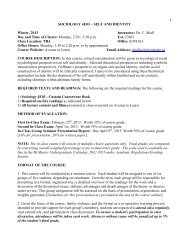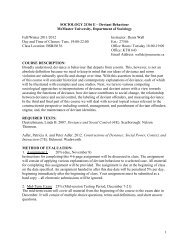samir saul2 sz.pub - Faculty of Social Sciences - McMaster University
samir saul2 sz.pub - Faculty of Social Sciences - McMaster University
samir saul2 sz.pub - Faculty of Social Sciences - McMaster University
Create successful ePaper yourself
Turn your PDF publications into a flip-book with our unique Google optimized e-Paper software.
Page 30 Globalization Working Papers 06/2<br />
The Latin American and the Caribbean share <strong>of</strong> inflows and outflows was not radically different<br />
in 2002 from what it was twenty years earlier. The low intake <strong>of</strong> the 1980s, stemming from the debt<br />
crisis, was more than made up in the 1990s. FDI amounted to three-fifths <strong>of</strong> total foreign capital inflows<br />
<strong>of</strong> $107 billion in 1997 (OECD 2001, 14, 19, 26). 44 Argentina experienced ups and downs, as did — not<br />
unexpectedly — tax havens, such as Bermuda and the Cayman and Virgin Islands. The other key Latin<br />
American recipients, Brazil and Mexico, were somewhat less affected by short-term swings.<br />
South and Southeast Asia's involvement in FDI increased notably. To all intents and purposes, the<br />
half dozen "tigers" garnered the bulk <strong>of</strong> Asia's FDI. China, the largest host country in the developing<br />
world, received the lion's share <strong>of</strong> inward FDI — almost half <strong>of</strong> South and Southeast Asia's total from<br />
the late 1990s45 — and Hong Kong was the main source <strong>of</strong> outward FDI (Li and Lui 1999; Tseng and<br />
Zebregs 2002). Noteworthy was the number <strong>of</strong> countries <strong>of</strong> the region involved in international capital<br />
flows. Indonesia, Malaysia, Thailand, and Vietnam (Freeman 2002; Brimble 2002) joined more<br />
established participants like the Re<strong>pub</strong>lic <strong>of</strong> Korea, Singapore, and Taiwan as major regional importers<br />
and exporters <strong>of</strong> capital. India's attitude toward FDI was ambivalent and its part in capital flows<br />
relatively small. Constraints on foreign investment were eased in 1984 and 1991, running counter to<br />
statist policies followed since independence. But administrative hurdles and <strong>pub</strong>lic suspicion, fuelled by<br />
accidents such as the gas leak at the Union Carbide plant at Bhopal which killed thousands, remained. 46<br />
As in Europe, regional integration stimulated capital flows and increased the number <strong>of</strong> countries active<br />
in FDI.<br />
Japanese outflows returned to South, East and Southeast Asia. Historically geared to securing<br />
natural resources and low-cost labour, mainly in Asia, they had been redirected to developed countries<br />
out <strong>of</strong> concern about mounting protectionism. Sizeable investments were made during the 1970s47and 1980s (Wall Street Journal, 16 January, 24 February, 2 March 1989; Financial Times, 13 January 1990)<br />
48 in the United States. In the 1990s, against the background <strong>of</strong> a slowdown <strong>of</strong> the Japanese economy and<br />
<strong>of</strong> Japanese foreign investments abroad, they were disposed <strong>of</strong>, as affiliates were sold <strong>of</strong>f and the<br />
proceeds shifted to closer and more promising markets (Wall Street Journal, 27 January 1993;<br />
Financial Times, 24 May 1994). 49 In East and Southeast Asia, "rapid economic growth — driven by<br />
some <strong>of</strong> the world's highest savings and capital-formation rates — <strong>of</strong>fers better returns than more<br />
mature markets in America, Europe or even Japan" (Wall Street Journal, 10 August 1993). 50<br />
In the early 1990s, nearly seven-tenths <strong>of</strong> the FDI flows out <strong>of</strong> East and Southeast Asia were<br />
intraregional, about a quarter went to North America, the balance to the European Union. Postwar links<br />
with the United States, as well as its unified market, made it more attractive than the fragmented and<br />
differentiated markets <strong>of</strong> Europe (UNCTAD 1996b, xiv, xv, 50; Wall Street Journal 26 October 1994).<br />
The pattern was similar in other developing countries: the main recipients <strong>of</strong> what outflows they<br />
generated were other developing countries. Insufficient experience <strong>of</strong> internationalization and lack <strong>of</strong><br />
means to confront stiff competition from the firms <strong>of</strong> developed economies gave precedence to more<br />
familiar markets where "transaction costs" (knowledge <strong>of</strong> local conditions, internal transportation and<br />
communications costs, regulations, and standards) were lower. Developed countries, especially in<br />
Europe, were not yet viewed as "a potential site for global sourcing in an integrated production strategy,<br />
but only, or mainly, as a market to be tapped by setting up a local production presence" (UNCTAD<br />
1996b, 48). As with the rise <strong>of</strong> the EU, servicing an entire region in the process <strong>of</strong> integration led to<br />
rationalization <strong>of</strong> production or distribution and choice <strong>of</strong> specific countries as gateways to the area.<br />
FDI inflows had a regional focus. Investment in the auto industry in Brazil was aided by MERCOSUR.<br />
FDI in the Southeast Asian countries owed much to the Association <strong>of</strong> South East Asian Nations<br />
(Indonesia, Malaysia, the Philippines, and Thailand).<br />
The list <strong>of</strong> leading recipient and source countries in the 1990s throws additional light on the<br />
distribution <strong>of</strong> flows <strong>of</strong> FDI in the world (see Appendix 7). The picture is complex, with some changes<br />
emerging against a background <strong>of</strong> continuity. Eight or nine developed countries were simultaneously




